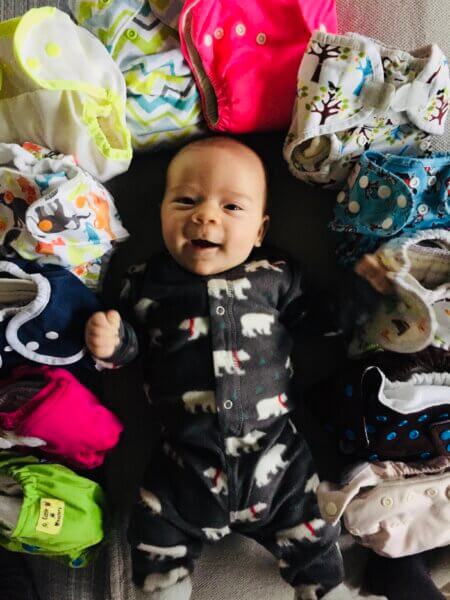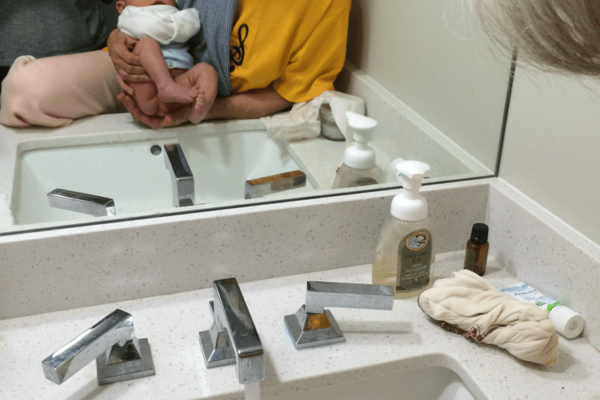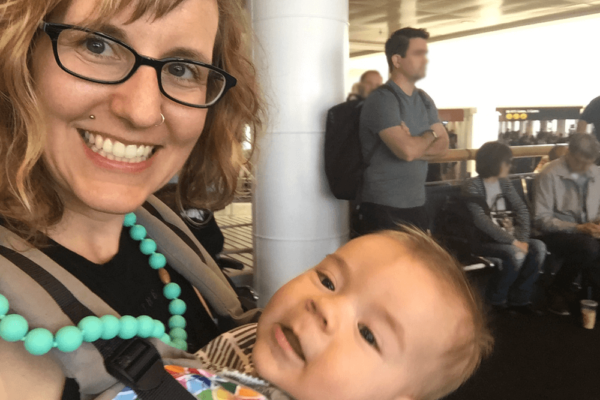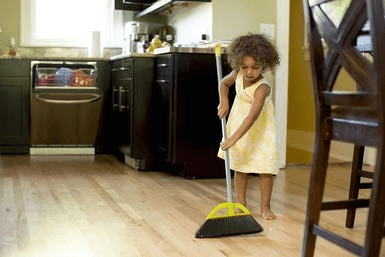Soaking it up with Cloth Diapers
When I was 24 years old I took a small motorboat through the Amazon jungle in Peru from Pucallpa to a village of the Shipibo tribe. The boat was full of locals returning to their home from the closest town with supplies. It was hot and sticky and the ride was long.
There were only a few hammocks on the boat and the smart folks got there early to claim their spots. When I arrived, a young woman with an infant was already lying there in a coveted and colorful hammock. I’ll always remember her face because what she did next would affect the choices I would make a decade later.
I envied her for her hammock. What a smart woman. She planned, she arrived early, she had everything under control for her and her baby. She was all of 17 from a local tribe yet she was more together than I with my perfectly packed backpack of survival gear. I was in awe.
Then, I watched her change her baby’s disposable diaper and throw it in the river.
I was shocked. But not upset with her…
…just sad for the river and the animals and what it all meant. For her, that’s just where the garbage went. Before the luxuries of the western world brought plastics to the jungles, all trash was actually biodegradable, literally from the jungle itself. She wasn’t malicious and she wasn’t the only one. Others on the trip ate their chocolate bars and threw the wrappers in the river. There was no trash pick up. No one was going to take care of it for them.
It was moments like this while travelling through South America and Asia that helped to make me environmentally conscious. When some of my friends and family started using cloth diapers, a lightbulb went off, and I decided cloth diapering was for me. Besides the fact that it cuts back on waste, it’s also cheaper (in the long run if you don’t go crazy buying new diapers). According to Cotton Babies, “By cloth-diapering exclusively, you can save approximately $1,200 or more over the 2-3 years your baby is in diapers.” You can also use these diapers for multiple children – even more savings! If you have the ability to take the time to do diaper laundry every couple of days, it really becomes a good option. But…
It is a lot of laundry.
I don’t judge others for not cloth diapering, I realize that it doesn’t work for everyone.(I love laundry. I know, I’m weird. It’s just so satisfying to fold and put those clean clothes away.) However, if you are considering it, DON’T BE AFRAID! It really isn’t as difficult and as expensive as it seems.
If you are a bit of a scientist or just want to have some good resources to lean on, here are some very helpful things I’ve learned along the way.
How to start your stash
There are so many types of diapers. There are pocket diapers, all in ones, fitted, covers with prefolds, etc. Just trying to figure out where to start can be overwhelming. In the beginning, you don’t need to get fancy. Ask friends for hand-me-downs, go to a consignment store, buy used ones from Craig’s list or mommy groups. Just watch for staining, stretched out elastic, or velcro that’s on it’s last leg. Strip and wash the diapers well before use. Stripping will get rid of any yeast infections or buildup that might be in the diapers that keep them from being absorbent. This is also a great thing to do while you are nesting at the end of your pregnancy.
I started with newborn Gdiapers that had compostable inserts, and a few Smart Bottoms newborn diapers with the umbilical cord cutout. This worked well for me when I was first recovering from the birth and wasn’t ready to do laundry every other day. Then, I switched to a few all-in-one diapers and the rest were just covers with prefolds which was a cheap way to get started. I got covers from some friends & family and then bought the rest from a consignment shop. The prefold inserts were only $20 a dozen.

Washing routine
The washing routine is SUPER IMPORTANT! Fluff Love University has a Facebook group where you can literally ask for help with a wash routine and great instructions on their website. You can also go to the website of your diaper brand to get information on a wash routine. This is where the scientist part comes in. You will need to tweak your routine to find out what works with your washing machine, detergent and load size.
A few tested tips
1. Use plenty of soap! Follow your washing machine guidelines for heavily soiled loads and read the fluff love detergent index for your detergent.
2) Wash every 2-3 days to avoid ammonia build up while they sit there dirty.
3) Fluff your load after the pre-wash
4) If you start to get barnyard or ammonia stink change up your wash routine ASAP. You can get help from the resources listed above.
I struggled with ammonia stink at first because
I wasn’t using enough detergent for my brand.
I was using Vaska soap and it’s a weak soap, so you need a lot of detergent to get your diapers clean. I also wasn’t filling my loads enough. Make sure you have a full load or there won’t be enough agitation. I’ve been adding in burp cloths, rags and socks to make a full load. (Hint: I add them after I do a pre-wash so they aren’t going in with the full poop and pee).
Other cool things about cloth
- Less diaper rash. The natural fibers are better for baby’s skin and the lack of chemicals helps too!
- I haven’t seen a blowout yet. You know when baby poops so much it blows up the back? Yeah, I haven’t had that.
- I don’t have to make late night runs to the store for diapers. I may have to do laundry but at least I can do this in my pajamas, or underwear, or my t-shirt covered in vomit.
- You can use cloth wipes too. More savings! Just wash them with your diapers (it helps to add bulk to your load as well).
- You can put the poop right in the washing machine. When you are strictly breastfeeding, poop is water soluable and will wash out in the machine, no problem. It’s not until they start eating solid foods that you have to scrape or spray the poop into the toilet.
There’s so much more to know about cloth diapering, especially if you super geek out over it like I have. Comment below on your cloth diapering experience, questions or thoughts. We’d love to hear from you!





Comments